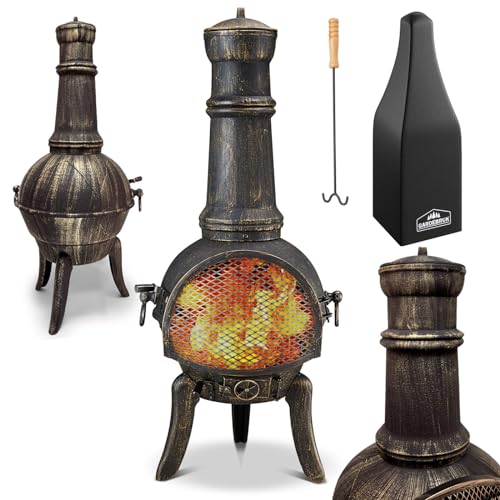Clay Chiminea - A Fun and Cosy Way to Enjoy the Outdoors

Clay Chimineas are an excellent way to enjoy the outdoors. If they are not handled with care, they may break or crack.
To prevent this from happening, it is essential to get rid of your chimenea. This means starting with small fires and allowing it to get hotter gradually. This will also stop sharp pieces of hot clay flying around.
How they're made
Chimineas from clay can be made with either air dried or kiln-dried clay. Kiln drying is the process of baking clay in a kiln above 1200 degrees. The clay is shaped either by hand or by casting it into a mold. After the clay has been formed and shaped, it can be painted (a substance such as glass or ceramic is placed on the surface) or left unglazed. It can also be painted to add some decoration.
Chimineas can be made of Terra cotta clay, which is the same type of clay used to make a lot of plant pots. Most chimineas today are made in Mexico. A flourishing business that provides local jobs. Chimineas are fired using small kilns, usually in batches of up to 100 Mexican chimineas at a time.
The clay is first rolled into long snakes that are then twisted together to form the chiminea's body. This is done by hand, with a bit of expertise, and it can be difficult to get the clay to the proper shape for a chiminea because they are usually quite large. Certain chimineas can also be thrown on a wheel like a pottery pot and require expert throwing skills and the use of tools like sponges to make the clay into the right shape.
After the chiminea has been created, it is dried in the sun or a oven for several days. Once it is dry, it is either glazed or left unglazed before being baked in the kiln at high temperatures. It can take several firings to glaze a clay chimney and achieve its full fireproofing potential.
Charcoal or wood can be used to fuel a
fire chiminea. Some people even use it for cooking. The most efficient fuel for a chimenea is wood, that burns less quickly and doesn't emit too much sparks. Utilizing a gas burner in the
tall chiminea isn't recommended as the clay can crack under the pressure of the flames.
When moving a chimenea, do not lift it up by the chimney or stack as this is a weak point and it will break easily. Instead, put one hand on the lip of the chimenea where the mouth or bowl opens and place the neck in a gentle position with the other hand.
The design
A clay chiminea is the perfect solution for anyone who wants to add a little space in their outdoor space or take advantage of the natural heat. These are easy to install and appear great however, if you put them incorrectly, they could break or even explode.
Regular cleaning is also required to eliminate ash, soot and other toxins from the inside. This helps keep the structure clean, and it looks more appealing as well. It is best to do this before attempting to light the fire, but it can be done afterwards, based on your preference. Regular cleaning reduces the danger of a chiminea being a victim of fire because the accumulation of dust can ignite and cause structural damage.
A layer of sand, or lava stone, may be positioned on the bottom of your fireplace. This will shield the clay from the heat generated by burning coals and wood that could cause it to crack. Many people use a bag of sand per Chiminea, but lava stones are a great alternative for those who prefer something more elegant.
You can also create a patio hearth to protect your chiminea and provide a fire-proof area for it to sit on. They are typically built by covering a part of a patio or deck with pavers or non-combustible materials, forming an elevated platform for your chiminea. This way, you can move the chiminea around as needed to prevent it from being too close to other structures or the vegetation It's also simple to extinguish a fire with water without worrying about the surrounding area becoming damaged.
It is recommended to pair a chiminea with grill. This lets you cook food while keeping your chiminea warm and gives you the opportunity to experiment with different cooking techniques, which isn't always possible with the traditional fire pit. Remember that chimineas can be heavy and should only be moved with the help of a person who can help or when fully cooled. They can also be extended by covering them when they are not in use.
The chimney
A chiminea is made up of a clay pot and a chimney. It is a fire feature that can be set up anywhere in the garden or yard to create warmth and ambiance. Chimineas are designed to burn wood or charcoal. They are also beautiful and can complement any patio furniture. They are easy to maintain and last for many years. They can be painted with non-toxic paints to match the decor. Covering it with a cover to shield it from elements and debris will increase the longevity of the product.
A chiminea made from clay, as any other pot, is vulnerable to various elements like rain and extreme temperature changes. To ensure that your chiminea is in good condition you must regularly clean it. Utilizing a stiff bristled toothbrush, you will need to remove all ash and dirt from the inside of your chiminea. The next step is to clean the exterior of your fireplace using some mild soap and a soft cloth.
It is also recommended that you put an additional layer of sand or rocks on the bottom of your
chiminea log burner. This will keep the hot coals from directly touching the clay and result in cracking of the heat. Lava stones are a popular choice and will provide you with an extra layer of protection for your chiminea.
While both cast iron and clay Chimineas can take a lot of heat, they need to be carefully maintained to prevent them from breaking or cracking. A chiminea that is damaged or cracked may crack open, releasing ashes and creating a
fire pit with chiminea hazard.
The majority of hardware stores stock high-temperature adhesives for repairing clay Chimineas. However, unlike traditional clay flowerpots, chimineas must be repaired using products that are able to endure high temperatures.

Like any fireplace that is built, Chiminea can generate hot flames when it is lit. To lessen the risk of this happening the risk, use well-seasoned and trimmed wood and a mesh screen or chicken wire at the top of the stack. Installing a metal grate on the opening of your chiminea can also aid in reducing the amount of sparks that come out of it.
The firebox
If you're looking to add a an easy and warm outdoor fire feature to your living space, the clay chiminea (also called a Chimenea) could be the ideal right thing. These simple, flexible units come in a variety styles and materials that will suit any garden or home.
Generally, these structures have a
fire pit with chiminea bowl, main body that feeds and holds the wood, and a short chimney stack for the removal of ash and smoke. Certain
chimineas might include grills and other cooking elements, which allows homeowners to use them as an outdoor kitchen.
A chiminea, like any clay pot, requires regular maintenance to ensure it is in good shape. The main issue with clay is that it can crack and break if subjected to extreme stress, such as sudden temperature changes. To avoid this it is recommended that you place your chiminea on a sturdy surface such as an fire pad, a fireplace pit or on concrete tile or stone.
It's essential to keep the flames of the fire bowl as tiny and as controlled as you can. A large fire can cause the clay to break and shatter. This can cause extremely sharp chunks of hot pottery to fly off and be hazardous to pets and children who may be around.
It is best to "season" the chiminea in the beginning before using it. It is recommended to make four to eight small fires to seal the clay. It is recommended to let the chiminea cool completely after each fire before trying another.
Once your chiminea has been properly well-seasoned, you can count on it to last for many years if cared for properly. Some modern chimineas use heavily grogged, heavy clay to withstand sudden temperature changes. This could cause other chimineas to break or crack. In wet weather, it's recommended to use a chiminea cover. This will protect it from rain, sleet, and reduce the amount heat lost during the rainy season.

 Clay Chimineas are an excellent way to enjoy the outdoors. If they are not handled with care, they may break or crack.
Clay Chimineas are an excellent way to enjoy the outdoors. If they are not handled with care, they may break or crack. Like any fireplace that is built, Chiminea can generate hot flames when it is lit. To lessen the risk of this happening the risk, use well-seasoned and trimmed wood and a mesh screen or chicken wire at the top of the stack. Installing a metal grate on the opening of your chiminea can also aid in reducing the amount of sparks that come out of it.
Like any fireplace that is built, Chiminea can generate hot flames when it is lit. To lessen the risk of this happening the risk, use well-seasoned and trimmed wood and a mesh screen or chicken wire at the top of the stack. Installing a metal grate on the opening of your chiminea can also aid in reducing the amount of sparks that come out of it.